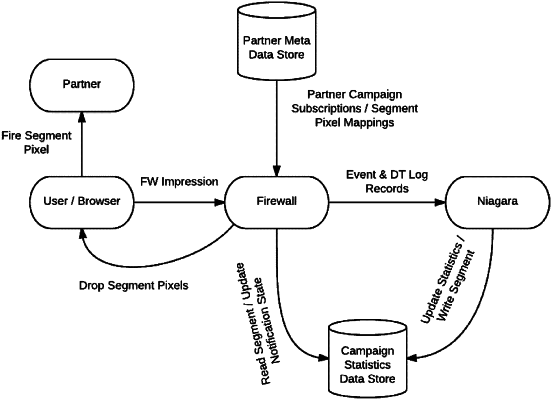| CPC G06Q 30/0246 (2013.01) [G06Q 30/0277 (2013.01)] | 18 Claims |

|
1. A method for presenting content, the method comprising:
receiving, using a hardware processor of a server device, consumption information of a plurality of content items associated with a plurality of viewers, wherein each content item is associated with browser code that transmits the consumption information on a browser application;
determining, using the hardware processor, from the consumption information obtained using the browser code, exposure frequency for each viewer of the plurality of viewers, exposure time of a set of content items provided to each viewer of the plurality of viewers, and lift for each viewer of the plurality of viewers;
receiving, using the hardware processor, from a partner device on which the browser application is executing, a cookie sync pixel that includes a request parameter that is set to a redirection URL associated with the server device and a cookie macro to a corresponding cookie value prior to redirection to the server device using the redirection URL;
transmitting a cookie sync request to the partner device that redirects the corresponding cookie value to the server device;
generating, using the hardware processor, based on the cookie sync request, a first heatmap that shows a distribution of the plurality of viewers in bins of exposure frequencies and exposure times to determine a threshold exposure frequency and a threshold exposure time to achieve an optimal lift based on the exposure frequency, the exposure time, and the lift, wherein the first heatmap is compared against a second heatmap of simulated users to determine the optimal lift;
generating, using the hardware processor, (i) a first user segment in which a plurality of additional content items should be provided to a viewer of the plurality of viewers, (ii) a second user segment in which at least one additional content item should be provided to the viewer of the plurality of viewers, and (iii) a third user segment in which no additional content items should be provided to the viewer of the plurality of viewers in which the exposure frequency is greater than the threshold exposure frequency and in which the exposure time is greater than the threshold exposure time, wherein at least one of the first user segment, the second user segment, and the third user segment is mapped to a content partner tag; and
automatically determining, using the hardware processor, whether a content provider should present the content item to the user device based on whether the user device is associated with a segment notification state corresponding to one of the first user segment, the second user segment, or the third user segment for the content item in the first request and based on a determination that a current user segment should be updated to a different user segment, wherein:
in response to determining that the segment notification state indicates that the user device should be assigned to the first user segment for the content item in the first request, the segment notification state causes the plurality of additional content items to be transmitted to the user device until determining that the user device should be assigned to the second user segment based on updated exposure frequency information and updated exposure time information;
in response to receiving a second redirected request for the content item and determining that the segment notification state indicates that the user should be updated from the first user segment to the second user segment, the segment notification state causes the at least one additional content item to be transmitted to the user device while the user device is positioned within the second user segment until determining that the user device should be assigned to the third user segment based on the updated exposure frequency information and the updated exposure time information; and
in response to receiving a third redirected request for the content item and determining that the segment notification state indicates that the user should be updated from the second user segment to the third user segment, the segment notification state causes the presentation of any additional content items to be automatically inhibited, without user intervention, on the user device by updating the mapping of the third user segment to the content partner tag and dropping the content partner tag.
|